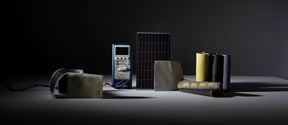Hidden photovoltaics enables freedom to design e-textiles
The Sun-powered Textiles project explores a practical and scalable solar cell textile technology

One of the goals listed in our project plan was to showcase the results of the Sun-powered Textiles project in a tangible way. The showcase would combine knowledge from all the project participants: Foxa’s expertise in the workwear fabrics, Lindström’s skills in workwear, and Haltian’s expertise in IoT and sensor technology as well as the Aalto team’s know-how in photovoltaics, textile design and textile electronics.
After discussing the objectives of the showcase in several workshops held during the project, we decided that it would be a jacket. A showcase jacket would demonstrate the aim and the results of the project to the shareholders and the customers well and help them imagine what else could be possible with the autonomous energy supply for textile wearables. As the model of the jacket, we chose one from the Lindström’s professional wear collection. Every participant chose their own fabric type for their own showcase jacket. This we thought would be a good way to present that the solar cell cover fabrics may vary according to the application, and to demonstrate that the solar cell textile product would be manufacturable at the industrial scale.
Fabrics for Foxa’s and Lindström’s showcase jackets will be provided by Foxa and they are commonly used in professional wear. Haltian and Aalto, on their side, will use special solar cover fabrics designed in the project. Lindström will sew the jackets, and Aalto team integrates the solar cells, the sensors chosen by Haltian, and the inter-connecting textile electronics in them.

Then, which research results will the showcase jackets portray? The study done within the Sun-powered Textiles bases on practical need to have reliable, energy-autonomous power-source for textile integration that meet the needs for textile use and care, design and manufacture. During the Sun-power textiles project, we have taken many different perspectives to the subject. Our research and development have involved:
In the Sun-powered Textiles project, our multidisciplinary collaboration has resulted in numerous findings. The jackets will highlight at least the following research results:
The jackets made of different fabrics shows the variety of design possibilities for readily applicable solar cell textiles. We hope they lead their audience to ponder: What new product or service concepts could we envision based on energy-autonomous solar-powered wearable or textile electronics?
Some of the showcase jackets, among other results of the project, will be presented to the public in Aalto University’s Designs for a Cooler Planet exhibition in Väre building, 8th – 29th September, 2021. The exhibition is part of Helsinki Design Week.
The Sun-powered Textiles team:
Elina Ilén, Janne Halme, Farid Elsehrawy, Elina Palovuori, Bettina Blomstedt, Pinja Helasuo, Jaakko Eskola, Zuzana Zmatekova, Linda Wederhorn, Maarit Salolainen
Learn more:


The Sun-powered Textiles project explores a practical and scalable solar cell textile technology

The research results of the Sun-powered Textiles project will be presented

Researchers of the Sun-Powered Textiles project answer the most frequently (un)asked questions about their textile-integrated solar cells.

The discrete nature of the cells protects them – and makes the clothes more attractive, the physics and design researchers say. Promising applications include work and outdoor clothing, and curtains which react to changes in the amount of light.

What is wise to design for future generations in a world of plenty?